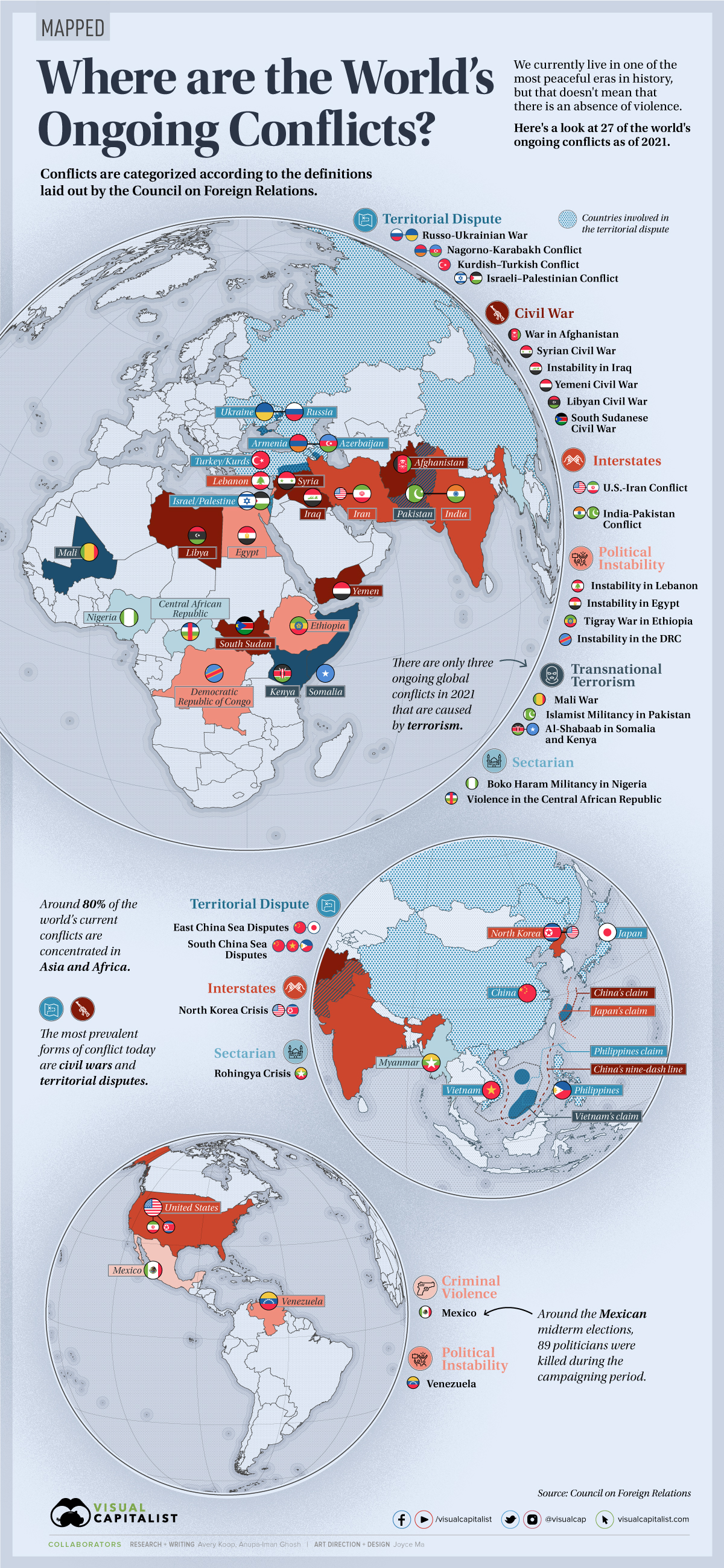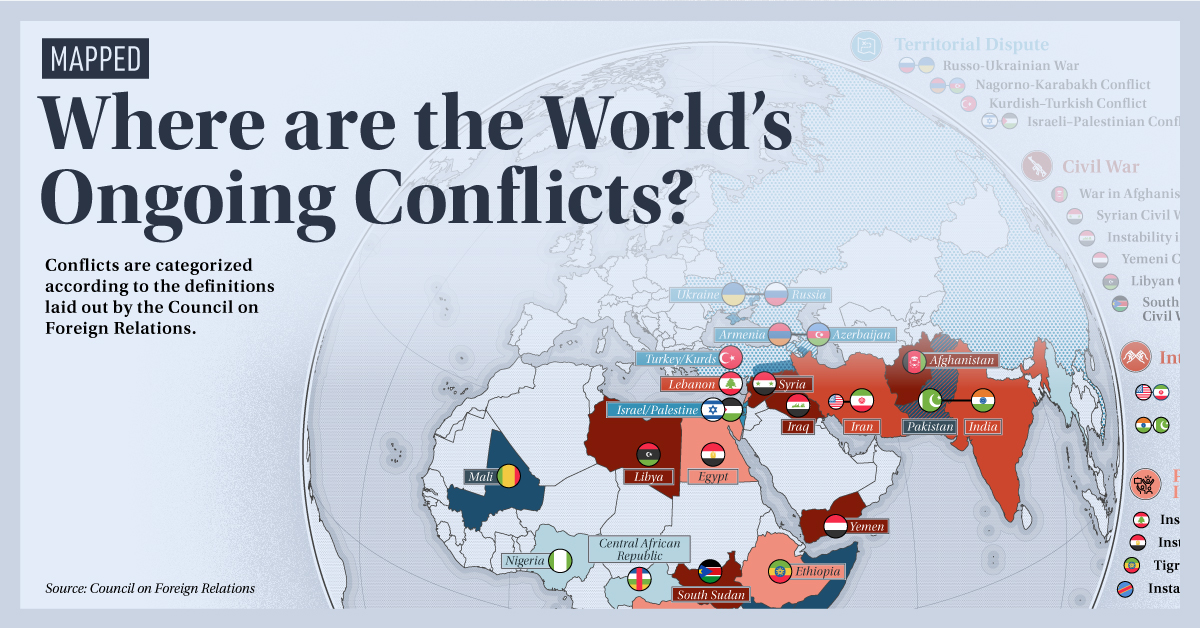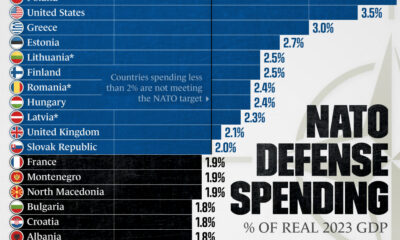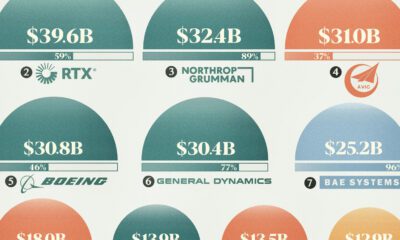Politics
Mapped: Where are the World’s Ongoing Conflicts Today?

Where are the World’s Ongoing Conflicts Today?
We live in an era of relative peace compared to most of history, however, this does not mean that there are no conflicts in the world today.
This map using data from the Council on Foreign Relations (CFR) reveals where the world’s 27 ongoing conflicts are today, and what type of conflicts they are.
Note: conflicts are categorized by definitions laid out by the CFR.
Detailing the Conflicts
Many people alive today have never lived through a war on their country’s soil, especially those in the West. But conflict, wars, and violence are by no means things of the past.
According to the Armed Conflict Location & Event Data Project (ACLED), as of Q2’2021 alone:
- Violence against civilians resulted in over 5,000 deaths worldwide
- Battle related deaths numbered over 18,000
- Explosion/remote violence led to more than 4,000 deaths
- Riots resulted in over 600 fatalities
Most of the world’s conflicts are concentrated in Asia and Africa and the most common forms are territorial disputes and civil wars. While terrorism often strikes fear in people, only three of the world’s ongoing conflicts are linked to terrorism, according to the CFR.
| Conflict Name | Type | Countries Involved |
|---|---|---|
| Civil War in South Sudan | Civil War | 🇸🇸 South Sudan |
| War in Yemen | Civil War | 🇾🇪 Yemen |
| Civil War in Libya | Civil War | 🇱🇾 Libya |
| War in Afghanistan | Civil War | 🇦🇫 Afghanistan |
| Civil War in Syria | Civil War | 🇸🇾 Syria |
| Instability in Iraq | Civil War | 🇮🇶 Iraq |
| Criminal Violence in Mexico | Criminal | 🇲🇽 Mexico |
| Confrontation of U.S. & Iran | Interstates | 🇺🇸 United States 🇮🇷 Iran |
| Conflict of India & Pakistan | Interstates | 🇮🇳 India 🇵🇰 Pakistan |
| North Korea Crisis | Interstates | 🇺🇸 United States 🇰🇵 North Korea |
| Violence in the DRC | Political Instability | 🇨🇩 DRC |
| Instability in Egypt | Political Instability | 🇪🇬 Egypt |
| Political Instability in Lebanon | Political Instability | 🇱🇧 Lebanon |
| Instability in Venezuela | Political Instability | 🇻🇪 Venezuela |
| Tigray War in Ethiopia | Political Instability | 🇪🇹 Ethiopia |
| Boko Haram in Nigeria | Sectarian | 🇳🇬 Nigeria |
| Violence in Central African Republic | Sectarian | 🇨🇫 Central African Republic |
| Rohingya Crisis in Myanmar | Sectarian | 🇲🇲 Myanmar |
| Nagorno-Karabakh Conflict | Territorial Disputes | 🇦🇲 Armenia 🇦🇿 Azerbaijan |
| Conflict in Ukraine | Territorial Disputes | 🇺🇦 Ukraine 🇷🇺 Russia |
| Israeli-Palestine Conflict | Territorial Disputes | 🇮🇱 Israel 🇵🇸 Palestine |
| Turkey & Armed Kurdish Groups | Territorial Disputes | 🇹🇷 Turkey |
| South China Sea Disputes | Territorial Disputes | 🇨🇳 China 🇻🇳 Vietnam 🇵🇭 Philippines |
| Tensions in East China Sea | Territorial Disputes | 🇨🇳 China 🇯🇵 Japan |
| Destabilization in Mali | Terrorism | 🇲🇱 Mali |
| Al-Shabab in Somalia | Terrorism | 🇸🇴 Somalia |
| Islamist Militancy in Pakistan | Terrorism | 🇵🇰 Pakistan |
As an example of a more typical conflict, Myanmar’s civil unrest began in February 2020 when the military overthrew the democratically elected government and arrested the country’s leader Aung San Suu Kyi. The civilian population has been protesting heavily but to no avail. According to a BBC report, more than 860 people have been killed and around 5,000 have been detained.
This is just one of the many examples of persistent violence today including recent events like Mexico’s midterm election violence, Ethiopia’s fighting in the country’s Tigray region, and the fighting between Israel and Palestine over the Sheikh Jarrah evictions.
Finally, though the United States military has now withdrawn from Afghanistan, and the Taliban has taken control of the country, the outlook for the country remains uncertain.
War and Peace
While there are conflicts today, deaths from violence and wars have and wars have decreased over time. For example, battle death rates in state-based conflicts have reduced significantly in a period from 1946 to 2016.
However, according to the UN, although battle related deaths have been decreasing, the number of conflicts occurring in the last few years has actually been on the rise (they have simply remained less deadly). Most conflicts have been waged by non-state actors, like organized criminal groups and political militias.
The UN found that the most common causes of conflict today are:
- Regional tensions
- Breakdowns in the rule of law
- Co-opted or absent state institutions
- Illicit economic gain
- Scarcity of resources exacerbated by climate change
Traditional war between countries and war-related deaths may be becoming a thing of the past, but the threat of violence is still very real. Many countries know this as they continue to build up armies and spend significant amounts on military and defense.
The Future of Warfare
War and conflict are still extremely relevant in the 21st century and impact millions of people. However, traditional warfare may be changing its shape and may become less deadly as a result.
For instance, issues like climate change will create further exacerbations on conflicts, and new forms of technological and cyber warfare could threaten countries’ elections and manipulate populations.
United States
Charted: What Southeast Asia Thinks About China & the U.S.
A significant share of respondents from an ASEAN-focused survey are not happy about rising American and Chinese influence in the region.

What Southeast Asia Thinks About China & the U.S.
This was originally posted on our Voronoi app. Download the app for free on iOS or Android and discover incredible data-driven charts from a variety of trusted sources.
This chart visualizes the results of a 2024 survey conducted by the ASEAN Studies Centre at the ISEAS-Yusof Ishak Institute. Nearly 2,000 respondents were asked if they were worried or welcoming of rising Chinese and American geopolitical influence in their country.
The countries surveyed all belong to the Association of Southeast Asian Nations (ASEAN), a political and economic union of 10 states in Southeast Asia.
Feelings Towards China
On average, a significant share of respondents from all 10 countries are worried about rising influence from both the U.S. and China.
However, overall skepticism is higher for China, at 74% (versus 59% for U.S.).
| Country | Worried About Growing 🇨🇳 Influence | Welcome Growing 🇨🇳 Influence |
|---|---|---|
| 🇧🇳 Brunei | 58% | 42% |
| 🇰🇭 Cambodia | 66% | 34% |
| 🇮🇩 Indonesia | 57% | 43% |
| 🇱🇦 Laos | 68% | 32% |
| 🇲🇾 Malaysia | 56% | 44% |
| 🇲🇲 Myanmar | 95% | 5% |
| 🇵🇭 Philippines | 81% | 19% |
| 🇸🇬 Singapore | 74% | 26% |
| 🇹🇭 Thailand | 84% | 16% |
| 🇻🇳 Vietnam | 96% | 4% |
| Average | 74% | 27% |
The recently-cooled but still active territorial concerns over the South China Sea may play a significant role in these responses, especially in countries which are also claimants over the sea.
For example, in Vietnam over 95% of respondents said they were worried about China’s growing influence.
Feelings Towards America
Conversely, rising American influence is welcomed in two countries with competing claims in the South China Sea, the Philippines (69%) and Vietnam (55%).
| Country | Worried About Growing 🇺🇸 Influence | Welcome Growing 🇺🇸 Influence |
|---|---|---|
| 🇧🇳 Brunei | 73% | 27% |
| 🇰🇭 Cambodia | 58% | 42% |
| 🇮🇩 Indonesia | 73% | 27% |
| 🇱🇦 Laos | 79% | 21% |
| 🇲🇾 Malaysia | 68% | 32% |
| 🇲🇲 Myanmar | 45% | 55% |
| 🇵🇭 Philippines | 32% | 69% |
| 🇸🇬 Singapore | 37% | 63% |
| 🇹🇭 Thailand | 80% | 20% |
| 🇻🇳 Vietnam | 45% | 55% |
| Average | 59% | 41% |
Despite this, on a regional average, more respondents worry about growing American influence (59%) than they welcome it (41%).
Interestingly, it seems almost every ASEAN nation has a clear preference for one superpower over the other.
The only exception is Thailand, where those surveyed were not a fan of either option, with 84% worried about China, and 80% worried about the U.S.
-

 Business6 days ago
Business6 days agoThe Top Private Equity Firms by Country
-

 Countries2 weeks ago
Countries2 weeks agoCountries With the Largest Happiness Gains Since 2010
-

 VC+2 weeks ago
VC+2 weeks agoVC+: Get Our Key Takeaways From the IMF’s World Economic Outlook
-

 Demographics2 weeks ago
Demographics2 weeks agoThe Countries That Have Become Sadder Since 2010
-

 Money2 weeks ago
Money2 weeks agoCharted: Who Has Savings in This Economy?
-

 Technology2 weeks ago
Technology2 weeks agoVisualizing AI Patents by Country
-

 Economy2 weeks ago
Economy2 weeks agoEconomic Growth Forecasts for G7 and BRICS Countries in 2024
-

 Wealth1 week ago
Wealth1 week agoCharted: Which City Has the Most Billionaires in 2024?


















